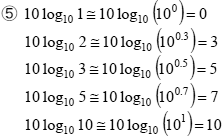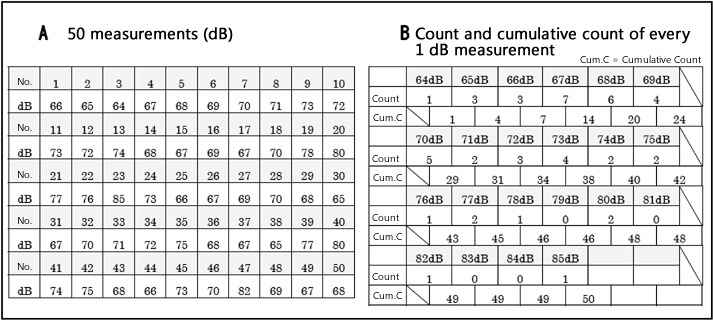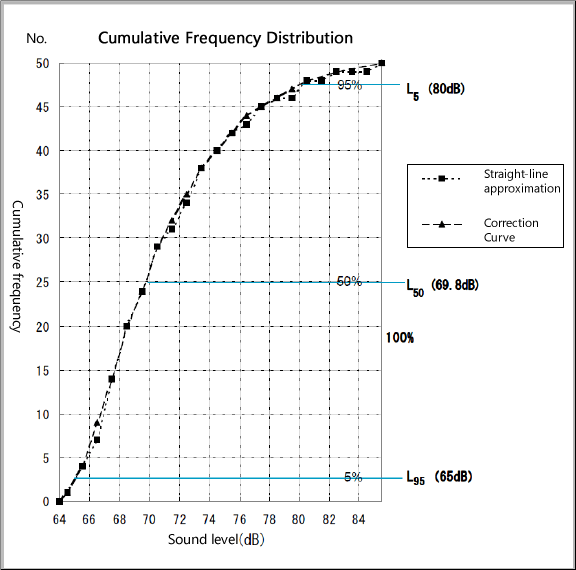What is sound level meter?
12. Calculation of deci Bel (dB)
Let us assume that we have two sound sources and their sound pressure levels are L1 (dB) and L2 (dB) respectively when they emit sound individually at different times. Now, when these sound sources emit sound at the same timing, the resultant sound pressure level is not simply equal to L1 +L2. To know the sound pressure level, we need to sum their deci Bels. The following paragraphs explain basic methods for calculating dB.
12-1 Sum of dB values (Total power)
Combined sound pressure level L from a number of sound sources can be determined as follows. The sound sources’ sound pressure levels L1, L2, ..... Ln (dB) can be calculated from the sound pressure at each source p1, p2, ..... pn:
| (Equation 12-1) |
|
where p0 is the reference value (p0 = 20 µpa). The above equation can be expressed in exponent notation as follows.
| (Equation 12-2) |
|
The sum L of these in dB is:
| (Equation 12-3) |
|
whereL is the combined sound pressure level. For example, 80 dB and 70 dB can be summed as follows.
| (Equation 12-4) |
|
Summing dB values is also called combining dB values.
12-2 Average of dB values (Average power)
The average L of the sum of n dB values can be determined by dividing the total power by n and the result is then logarithm-converted into dB, as follows.
| (Equation 12-5) |
|
where L is the sum determined in Section 12-1. Therefore, the average can be obtained by subtracting 10 log10 n from the sum of the dB values. For example, the average power of 80 dB and 70 dB can be calculated as follows.
| (Equation 12-6) |
|
12-3 Difference of dB values (Power differential)
The difference L' between L1 (dB) and L2 (dB) can be expressed as follows.
(Equation 12-7) |
|
For example, the difference between 80 dB and 70 dB can be calculated as follows.
| (Equation 12-8) |
|
The above method for differential dB calculation can be used for background noise correction in specific noise measurement. If the sound pressure level L1 (dB) including specific and background noise and the sound pressure level L2 (dB) (background noise) without specific noise are known, the difference, or the level of the specific noise, can be calculated.
As described in Section 4-1, deci Bel (dB) is ten times the logarithm to base 10 of the ratio of a physical quantity (power) to the reference sound pressure. This means that it is essential to understand logarithmic calculation. Here are some of the basic characteristics of logarithm.
< Basic characteristics >
The number 1000 can be expressed as 103 in exponent notation. This relationship can be expressed using logarithm to base 10 as log 10103 = 3. Generally,
| (Equation 12-9) |
|
The relationship between antilogarithm and logarithm, which is often used in noise calculation, is outlined below
|
Table 12-1: Basic logarithmic equations and examples |
|
|
 |
12-5 Method of calculating equivalent continuous A-weighted sound pressure level
ISO 1996 (JIS Z 8731) specifies methods for measuring equivalent continuous A-weighted sound pressure level, which is used for evaluating noise in general environments, work environments and in other conditions. Equivalent continuous A-weighted sound pressure level can be calculated automatically using integrating sound level meters with that specific computation feature. However, even when using sound level meters that do not have that function, equivalent continuous A-weighted sound pressure level can be determined by averaging measured sound pressure levels (dB) as shown below. Based on sound pressure levels measured at regular intervals, the equivalent continuous A-weighted sound pressure level LAeq of the measurement time intervals can be determined using the following equations
|
(Equation 12-10) |
 |
where T is measurement time interval, n is the total number of measurements and LA1, LA2 and LAn are measured sound pressure levels (dB)
12-6 Method of measuring percentile sound pressure level (50 measurements)
Percentile sound pressure level is used for measuring and evaluating fluctuating noise. The following procedures must be followed to obtain percentile sound pressure levels. First, set time weighting to Fast, take 50 measurements at 5-second intervals and note the measurements in the order they were taken like in Field A of Table 12-2. Second, sort out the measurements based on the levels and enter the subtotals in a number-of-times table like Field B of Table 12-2.
While measurements are normally indicated to the first decimal place, determine the division of the scale to be used according to the required resolution and count the measurements that fall under the same divisions. The example shown below uses a 1 dB division for ease of explanation and understanding. Enter the subtotals in a number-of-times table organized in the order of low to high numbers like in Field B of Table 12-2 and then enter cumulative numbers in the same table. Then, plot the table’s data in a graph like the one in Figure 12-1, in which the Y axis represents cumulative numbers like 1, 4 and 7 while the X axis represents sound pressure levels like 64.5, 65.5 and 66.5. Draw a smooth (correction) curve along the points plotted. This represents the distribution of cumulative measurements. Using the percentage scale and the distribution curve, determine the 95 % value. This is the upper limit L5 of the 90 % range. Likewise, the 50% value is the median value L50 and the 5% value is the lower limit L95 of the 90 %.
Table 12-2: Example of 50 measurements of determining percentile sound pressure level


Figure 12-1: Percentile sound pressure level and cumulative distribution